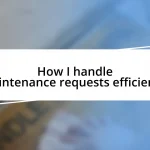Key takeaways:
- Regular property inspections are essential for early detection of issues, tenant satisfaction, and maintaining property value.
- Building rapport with tenants enhances communication and can uncover concerns that improve their living experience.
- Following up with property owners and tenants after inspections fosters trust and can lead to timely repairs and enhanced property value.

Introduction to Rental Property Inspections
When I first started my journey with rental property inspections, I was both excited and apprehensive. The thought of stepping into someone else’s space and scrutinizing every little detail felt a bit daunting. Yet, the realization that I was helping both landlords and tenants ensured that I embraced the process with open arms.
As I conducted my first few inspections, I quickly learned that these assessments aren’t just about checking boxes on a list; they play a crucial role in maintaining the integrity of rental properties. Each inspection became a lesson in understanding not only the physical state of a property but also the emotional investment that landlords have in their investments. Have you ever thought about how a small issue, left unchecked, could snowball into an expensive repair? I’ve seen it happen.
Over time, I discovered that fostering open communication with tenants during inspections is key. I remember a particular inspection where a tenant shared concerns that hadn’t been voiced before, leading to immediate action. It struck me then—inspections are not solely about the property; they are an opportunity to build trust and rapport. How often do we overlook the human element in such processes? Each interaction can turn a routine inspection into a meaningful dialogue, making the experience valuable for everyone involved.

Importance of Regular Inspections
Regular inspections are essential for maintaining the value of rental properties and ensuring tenant satisfaction. I’ve experienced firsthand how a comprehensive examination of a property can uncover hidden issues that might otherwise lead to bigger headaches down the road. For instance, during one inspection, I noticed a small water stain on the ceiling that the tenant had overlooked. What seemed like a minor cosmetic issue turned out to be a leaky pipe, which, if left unattended, could have resulted in significant water damage and costly repairs.
The benefits of conducting regular inspections can’t be overstated. Here are a few reasons why they should be a priority:
- Early Detection: Identifying potential problems before they escalate can save both time and money.
- Tenant Assurance: Regular check-ups make tenants feel valued and safe in their homes.
- Property Value Preservation: Maintaining the property ensures its longevity and optimal rental value.
- Documentation: Keeping a record of inspections helps in maintaining transparency with all parties involved.
- Improved Relationships: Regularly engaging with tenants builds trust and fosters open communication.
Every inspection not only reassures the property owner but also strengthens the relationship with tenants, making it clear that their comfort and safety matter deeply.

Preparing for Your First Inspection
Preparing for your first rental property inspection can feel overwhelming, but taking a structured approach helps ease any anxiety. I recall my first inspection where I meticulously gathered tools and checklists—everything from a flashlight to record issues to a camera for documentation. The moment I stepped into the property, I realized that preparation isn’t just about what’s in your hands; it’s also about the mindset you bring. Are you ready to look beyond the surface?
Understanding the physical property is important, but ensuring you’re also familiar with any local regulations governing inspections can make a world of difference. I learned this the hard way when my excitement for my first inspection clouded my awareness of specific codes. A friendly conversation with another inspector illuminated the importance of these regulations, prompting me to spend some time studying local laws. This knowledge not only boosted my confidence but made the inspection process more efficient and credible.
Finally, I found that establishing a rapport with tenants during the inspection is crucial. I remember the day I arrived and was met with nervous expressions—understandably so! So instead of diving straight into the inspection, I took a moment to introduce myself and ease their minds. It was heartwarming to see them relax, and the open dialogue that followed allowed for honest feedback. Have you considered how a friendly approach can transform a routine task into a collaborative experience?
| Preparation Aspects | Importance |
|---|---|
| Gathering Tools | Ensures you’re equipped to identify and document issues. |
| Understanding Regulations | Helps avoid potential legal pitfalls and enhances your credibility. |
| Building Rapport with Tenants | Creates a cooperative environment, facilitating open communication. |

Key Aspects to Inspect
When inspecting a rental property, I always pay close attention to the condition of the plumbing. It’s surprising how often small leaks or rusted pipes can go unnoticed in busy homes. Just the other week, I spotted a tiny drip under the sink during an inspection that could easily have been missed. That minor issue could have escalated into major water damage if left unchecked. Have you ever thought about how much money you could save by simply checking your plumbing?
Another key aspect I look into is the electrical system. Ensuring that outlets, wiring, and fixtures are up to code is crucial not only for tenant safety but also for your peace of mind. I once had a situation where I noticed an outdated fuse box in a property. The tenants felt uneasy using certain appliances, fearing an overload. Addressing that issue by upgrading the electrical system not only improved safety but also increased tenant satisfaction. Isn’t it rewarding to know your actions can directly enhance someone’s living experience?
Lastly, I never underestimate the significance of structural integrity during my inspections. Cracked walls or uneven floors may seem like cosmetic flaws, but they can indicate deeper foundational issues. I recall inspecting a unit where the tenant had grown accustomed to small cracks and settled floors, brushing them off as minor concerns. After further investigation, we discovered a larger issue that needed immediate attention. What do you think: could a simple inspection help you uncover hidden problems before they become nightmares?

Best Practices for Conducting Inspections
One of the best practices I’ve adopted over the years is to create a detailed inspection checklist tailored to each property type. This approach not only keeps me organized but also ensures I don’t overlook important areas. I remember a time when I neglected to check the attic during an inspection, only to find out later that the roof had significant wear. Have you ever had that moment when a quick check could have saved you a lot of trouble?
Communication is another essential aspect of conducting inspections effectively. I always encourage tenants to share their experiences and concerns about the property’s condition. During one inspection, a tenant pointed out a draft coming from a window that I hadn’t noticed. Thanks to their input, we were able to address the issue promptly. Engaging tenants in conversation often reveals insights that are not immediately visible. Don’t you think your tenants could be your best allies in maintaining the property?
Lastly, I strongly believe in following up after an inspection. Sending a concise report to the property owner not only reflects professionalism but also fosters trust. I take the time to highlight key findings along with recommendations. I once received a heartfelt message from an owner expressing gratitude for my thoroughness, which reinforced my commitment to excellence. Have you considered how effective communication post-inspection can lead to long-term relationships?

Common Issues to Look for
When inspecting rental properties, I often find myself looking closely at the state of windows and doors. I recall one inspection where the tenant had a beautiful view, but upon closer scrutiny, I noticed several windows were difficult to close. It was easily overlooked, but I knew it could lead to security concerns and increased energy bills. Have you ever considered how something as simple as a window latch could impact a tenant’s comfort?
Another common issue I frequently check for is the condition of flooring. It’s interesting how worn carpets and cracked tiles can affect both aesthetics and safety in a rental. During a recent inspection, I stumbled upon a loose floorboard that posed a tripping hazard. I still remember the look of relief on the tenant’s face when I assured them it would be fixed promptly. Isn’t it fascinating how addressing minor flooring issues can make such a significant difference in someone’s daily life?
Lastly, I pay special attention to mold and mildew, especially in bathrooms and basements. These hidden threats can not only cause health issues but can also damage a property’s structure. I once toured a unit that looked pristine, but upon closer inspection, there were early signs of mold behind the shower tiles. The tenant had noticed a musty smell but wasn’t sure where it was coming from. Tackling such problems early on is crucial—after all, who wants a moldy environment to deal with?

Follow-Up Actions After Inspections
After completing an inspection, I always prioritize reaching out to property owners with a follow-up report. I remember one instance where I laid out my findings in a clear document, which included photographs and a detailed list of necessary repairs. The owner’s response was overwhelming; they appreciated my diligence and it ultimately led to a series of improvements that enhanced the property’s value. How do you think a well-crafted report could influence your owner’s engagement?
Following up with tenants is equally important. After one inspection, I decided to send a quick email to the tenants thanking them for their cooperation and encouraging them to share any lingering concerns. To my surprise, they not only felt valued but also reported a minor plumbing issue that I had missed. Engaging tenants post-inspection can often uncover problems that might otherwise go unnoticed. Isn’t it interesting how a simple gesture can foster open communication and trust?
Finally, I make it a point to schedule follow-up actions based on the inspection outcomes. For instance, there was a time when I identified several maintenance tasks that needed urgent attention. I created a timeline for repairs and shared it with the property owner, which not only demonstrated my commitment but also helped coordinate the repair work efficiently. Isn’t it vital to have a proactive approach in maintaining properties?














